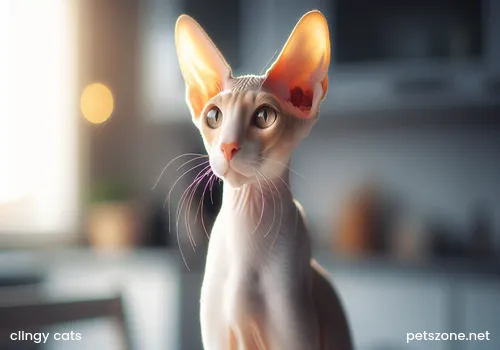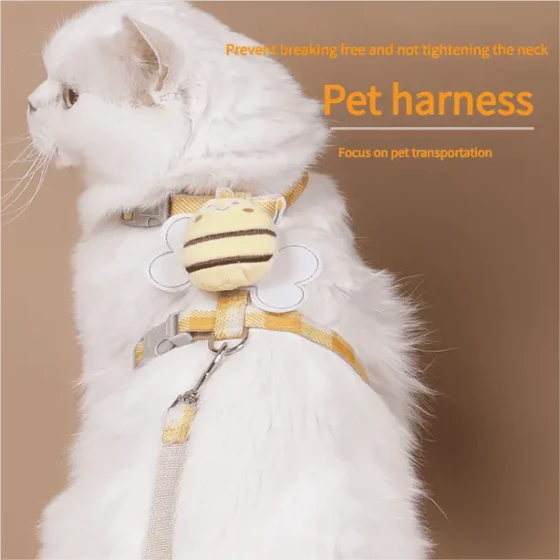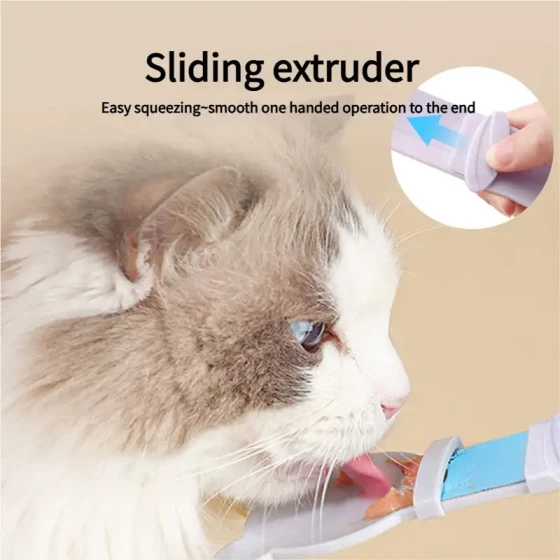Clingy Cats_Happy Troubles of Raising Cats
Clingy cats, this is probably one of the sweetest “troubles” for cat owners. When you eagerly expect to raise an independent and aloof feline master, imagining it as a detached recluse who only occasionally graces you with attention, but end up bringing home a “human-shaped accessory” that follows you everywhere and meows if out of sight for a moment, as if it can’t survive without you. Is this a symbol of happiness or some hidden signal?
Clingy behavior in cats may be a deep link of trust and attachment, but it can also be a sign of boredom, stress, or even health problems. Exactly, the clingy behavior of cats is far more than just “loving you”; it is like a complex cipher book recording the cat’s personality, experiences, emotions, and physical condition, requiring our patience to interpret.

We generally think cats are aloof loners who do not express emotions as enthusiastically as dogs do. But this is actually a misconception. Cats are also social animals, capable of establishing deep trust and emotional bonds with humans, even depending on us like family. When you become the trusted “head of the family” for your cat, they express this attachment in various ways, the most direct being “clinginess.”
Why are some cats such “clingy pests”?
The degree of clinginess in cats is not uniform and is influenced by multiple factors:
- Innate personality and breed genes: Some cats are naturally more affectionate and loving. For example, Ragdolls, Siamese, Maine Coons, British Shorthairs, and Russian Blues are generally considered more clingy breeds. It’s like human personalities; some are naturally extroverted, others more introverted.
- Early experiences and socialization: Early life experiences matter greatly. If a kitten has positive interactions with humans during the critical socialization period (usually 2 to 8 weeks old) and is provided with enough security, it will grow up more people-oriented. Conversely, early weaning or stressful environments can cause insecurity, leading to clinginess to seek comfort.
- Building security and trust: Cats need time to build trust. Providing a stable, safe living environment, meeting basic needs (food, water, clean litter box, safe resting places), along with patient and positive interaction, helps them gradually trust you and show closeness and attachment. Cats rubbing their heads on you, leaving their scent, or showing their belly are expressions of trust and affection.
- Changes with aging: Like humans, cats’ needs and behaviors vary with age. Kittens are usually clingier as they rely on their mothers or humans for care and safety. As they grow older, some cats become more independent, but some elderly cats may become clingier due to health, vision, or cognitive declines, seeking more security and companionship.
- Environmental changes and stress: Moving houses, changes in family members (new pets or humans), or changes in the owner’s work schedule can make cats feel uneasy or stressed. In such cases, they may become clingier, trying to find comfort and reassurance from you.
- Boredom and seeking attention: Sometimes, cats are clingy simply because they are bored or want to get your attention for food, play, or litter box service. If you respond immediately to their “meow,” they will soon learn to use clinginess to manipulate you, turning you into their “exclusive servant.”
- Potential health problems: It is important to note that sudden changes in behavior, including becoming unusually clingy, can be a sign of physical discomfort or illness. If your previously aloof and independent cat suddenly clings to you constantly or shows other abnormal symptoms (such as loss of appetite, lethargy, abnormal elimination), be sure to take it to the vet promptly to rule out health issues.
When clinginess becomes a “trouble”: How to cope with excessive clinginess?
While being deeply loved by your cat is a happiness, excessive clinginess, especially when it develops into separation anxiety, can cause problems for both cat and owner. Cats with separation anxiety may show excessive vocalization when you leave, elimination outside the litter box, destructive behavior, changes in appetite, or even vomiting or diarrhea. If you notice these signs, some steps might be necessary:
- Rule out health problems: Sudden behavior changes should first consider health problems. Taking your cat for a thorough veterinary checkup is the first step.
- Enrich the environment: Provide enough play opportunities and mental stimulation to reduce boredom. You can prepare interactive toys, cat trees, scratching posts, or puzzle feeders so they can entertain themselves when you are not home.
- Establish regular routines: Cats are creatures of habit; a stable routine makes them feel secure. Try to feed, play, and rest at fixed times.
- Encourage independence: Consciously nurture your cat’s independence. Don’t respond immediately to every meow or clingy behavior. Try to give attention and rewards when they are calm. Train them to stay in a separate space alone for gradually longer periods.
- Set gentle boundaries: If your cat interrupts you during work or rest, gently move them away or provide an alternative comfortable area. For example, if you don’t want them kneading on your lap, place a soft blanket nearby and guide them there.
- Adjust interactions when leaving and returning: Try to leave quietly without long goodbye rituals. When returning, avoid overly enthusiastic greetings; wait until your cat calms down before interacting. This helps reduce associating your departures and arrivals with extreme emotions.
- Consider introducing a companion: If you have a single-cat household and your cat shows signs of boredom or loneliness, carefully consider adopting another compatible cat to keep each other company and reduce overdependence on you. Of course, introducing a new member requires patience and proper methods to ensure peaceful coexistence.
- Seek professional help: If your cat’s excessive clinginess or separation anxiety seriously affects daily life, consider consulting a professional pet behaviorist or veterinary behaviorist. They can provide targeted behavior modification plans and, if necessary, assist with medication.
Embrace this sweet burden
Of course, for most clingy cats, their behavior mainly stems from trust and love for you. They regard you as their most important support and want to share every moment of life with you. The feeling of being “needed” and “attached” is one of the greatest joys of cat ownership.
So when you are entangled by a clingy pest, don’t rush to feel annoyed or boast. Instead, try to understand the reasons behind the behavior. Is it simply wanting affection? Hungry? Or feeling unwell? Spend more time observing and understanding your cat, and you will find this “clinginess” is not just sweetness but a unique way they sincerely communicate with you. After all, being chosen and deeply loved by an aloof and independent cat is itself an indescribable honor, isn’t it?
References:
- Hill's Pet Nutrition article: "Managing Clingy Cats: Do I Have a Velcro Kitty?"
- Sploot Vets article: "Why is My Cat so Clingy: 8 Reasons"
- Zoetis Petcare article: "I Have a Clingy Cat. What Now?"
- Noots Pets article: "Why Is My Cat so Clingy? A Guide to Overly Needy Cats"
- ASPCA Pet Health Insurance article: "Separation Anxiety in Cats"
- Purina Institute article: "Tips to Soothe Cats and Dogs with Separation Anxiety"
- NetEase article: "What to Do When Your Cat Is Too Clingy? Netizens: Isn't It Too Pretentious!"
- NetEase article: "An Aloof Cat Suddenly Becomes Clingy, Possible Disease Factors"
- QQ News article: "Why Aren't Adult Cats as Clingy as Kittens?"
- Sina article: "These Cat Behaviors Show Deep Love for You"
- QQ News article: "Why Does an Aloof Cat Become a ‘Clingy Pest’ in the Morning?"
- NetEase article: "Is Your Cat a ‘Follower’? Which Owner Behaviors Cause Cats to Be Too ‘Clingy’?"
- Reveal Pet Food article: "The Signs Your Cat Has Separation Anxiety (and What to Do About It)"
- PetMD article: "Why Is My Cat So Cuddly and Affectionate?"
- Vet Organics article: "Bonded Cats & Their Mysterious Social Structures Part 1"
- PetMD article: "How To Bond With Your Cat"
- Sheba® Philippines article: "Cat Bonding Guide - Learn How To Bond With A Cat"
- People's Daily article: "The 5 Characteristics That Make 'Cat-Appealing' Cat Lovers, How Many Do You Have?"



-560x560.webp)